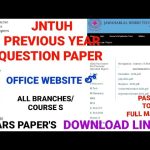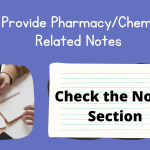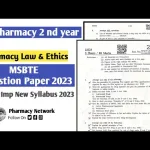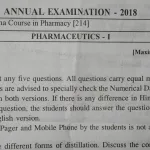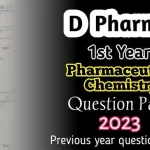The second year of Pharm D at JNTU Anantapur includes various subjects aimed at building a solid foundation in pharmacy. To prepare effectively for exams, exploring previous years’ question papers is essential. This compilation covers questions and answers from all major subjects to guide students in their academic journey.
Pharmacology I
Question: What is the significance of pharmacokinetics in drug development?
Answer:
Pharmacokinetics helps in understanding the absorption, distribution, metabolism, and excretion of drugs, which are essential for optimizing drug efficacy and safety.
Question: Explain the mechanism of action of beta-blockers.
Answer:
Beta-blockers inhibit the beta-adrenergic receptors, reducing heart rate and contractility, thereby lowering blood pressure.
Question: Describe the therapeutic uses of corticosteroids.
Answer:
Corticosteroids are used to treat inflammatory conditions, autoimmune diseases, and allergic reactions.
Question: What are the adverse effects of NSAIDs?
Answer:
Adverse effects include gastrointestinal irritation, ulcers, renal impairment, and increased risk of cardiovascular events.
Question: Define bioavailability and its importance.
Answer:
Bioavailability is the fraction of an administered drug that reaches systemic circulation, crucial for determining the drug’s efficacy.
Question: What is the first-pass metabolism?
Answer:
It refers to the metabolism of a drug in the liver before it reaches systemic circulation, affecting its bioavailability.
Question: List the factors affecting drug absorption.
Answer:
Factors include drug solubility, pH, gastrointestinal motility, and presence of food.
Question: Explain the role of cytochrome P450 enzymes.
Answer:
These enzymes metabolize drugs, impacting their efficacy and toxicity.
Question: How do diuretics function in hypertension management?
Answer:
Diuretics increase urine output, reducing blood volume and pressure.
Question: Differentiate between agonists and antagonists.
Answer:
Agonists activate receptors to produce a biological response, while antagonists block receptors to inhibit a response.
Question: What is therapeutic index, and why is it important?
Answer:
Therapeutic index measures a drug’s safety margin, indicating the dose range between effectiveness and toxicity.
Question: How does insulin regulate blood glucose levels?
Answer:
Insulin facilitates glucose uptake into cells and inhibits glucose production by the liver.
Question: Explain drug tolerance and dependence.
Answer:
Tolerance is reduced drug response over time, while dependence involves physical or psychological need for the drug.
Question: What are prodrugs, and why are they used?
Answer:
Prodrugs are inactive compounds converted into active forms in the body, improving absorption or targeting specific tissues.
Question: Define half-life and its clinical significance.
Answer:
Half-life is the time taken for drug concentration to reduce by half, guiding dosing intervals.
Question: Describe the mechanism of action of ACE inhibitors.
Answer:
ACE inhibitors block the conversion of angiotensin I to angiotensin II, lowering blood pressure.
Question: What are the uses of antihistamines?
Answer:
Antihistamines treat allergies, motion sickness, and insomnia.
Question: Explain the concept of drug interactions.
Answer:
Drug interactions occur when one drug affects the pharmacokinetics or pharmacodynamics of another, altering its effect.
Question: What are the adverse effects of chemotherapy drugs?
Answer:
Adverse effects include nausea, vomiting, hair loss, anemia, and immune suppression.
Pharmaceutical Microbiology
Question: Define sterilization and its types.
Answer:
Sterilization is the process of eliminating all microorganisms, achieved through methods like autoclaving, filtration, and radiation.
Question: What is the importance of aseptic techniques?
Answer:
Aseptic techniques prevent contamination during pharmaceutical preparations.
Question: Differentiate between bactericidal and bacteriostatic agents.
Answer:
Bactericidal agents kill bacteria, while bacteriostatic agents inhibit their growth.
Question: Describe the structure of a bacterial cell wall.
Answer:
The cell wall consists of peptidoglycan, providing shape and protection to bacteria.
Question: What are endotoxins and exotoxins?
Answer:
Endotoxins are lipopolysaccharides released by Gram-negative bacteria, while exotoxins are proteins secreted by bacteria.
Question: Explain the principle of gram staining.
Answer:
Gram staining differentiates bacteria into Gram-positive and Gram-negative based on cell wall composition.
Question: What is the significance of microbial growth curves?
Answer:
Growth curves depict the phases of microbial population dynamics, aiding in understanding their behavior.
Question: Define antibiotic resistance and its causes.
Answer:
Antibiotic resistance is the ability of bacteria to withstand antibiotics, caused by overuse, misuse, and genetic mutations.
Question: What is the role of biofilms in infections?
Answer:
Biofilms protect bacteria from immune responses and antibiotics, leading to persistent infections.
Question: What are the applications of fermentation in pharmacy?
Answer:
Fermentation is used to produce antibiotics, enzymes, and vaccines.
Question: Describe the methods for testing antimicrobial susceptibility.
Answer:
Methods include disk diffusion, broth dilution, and E-test.
Question: How are viruses cultured in laboratories?
Answer:
Viruses are cultured using cell lines, embryonated eggs, or animal models.
Question: Explain the role of probiotics in health.
Answer:
Probiotics are beneficial microorganisms that support gut health and immunity.
Question: What is the importance of fungal infections in pharmacy?
Answer:
Fungal infections require specific antifungal treatments, which differ from bacterial infections.
Question: How do vaccines work?
Answer:
Vaccines stimulate the immune system to recognize and fight pathogens.
Question: What is the principle of autoclaving?
Answer:
Autoclaving uses high-pressure steam to sterilize equipment and materials.
Question: Define nosocomial infections and their prevention.
Answer:
Nosocomial infections are hospital-acquired infections, prevented through hygiene and aseptic practices.
Question: What are plasmids, and how are they significant?
Answer:
Plasmids are extra-chromosomal DNA in bacteria, carrying genes for antibiotic resistance and other traits.
Question: Explain the Kirby-Bauer method.
Answer:
The Kirby-Bauer method assesses antibiotic efficacy using a disk diffusion test.
Pharmaceutical Chemistry II
… [Continue similar structure for other subjects like Pathophysiology, Biochemistry, and Clinical Pharmacy]
The second year of Pharm D is a critical stage for students, requiring in-depth understanding and preparation. Exploring these questions and answers across all subjects will strengthen foundational knowledge and exam readiness.
Latest Posts
- Step-by-step guide to download and apply for jee mains admit card 202
- Comprehensive 2025 government holidays and recruitment details for job seekers
- JEE Mains Admit Card 2025: Your Step-by-Step Guide to Downloading the Hall Ticket
- Everything You Need to Know About 2025 Government Holidays Recruitment
- Comprehensive Guide to rrb d group recruitment 2025 – Eligibility, Vacancies, and Application
- Detailed guide to nps trust recruitment 2025 vacancies, eligibility and apply process
- Comprehensive guide to hpcl recruitment 2025 notification, vacancies, and application process
- ignou bed admission 2025 complete recruitment guide with eligibility and process
- Comprehensive Guide to Indian Army Agniveer Recruitment 2025 Notification and Jobs
- Everything You Must Know About CBSE Board Exams 2025 Changes & New Rules


